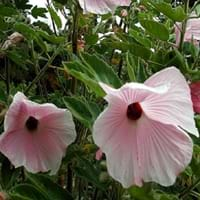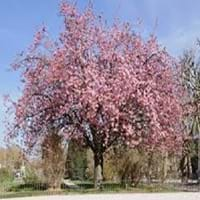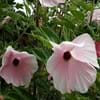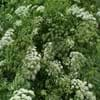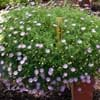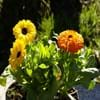Life Span
Annual and Perennial
Perennial
Type
Flowering Plants, Ornamental Plants, Shrub, Tree
Tree
Origin
Eastern Australia
China, Japan, Korea
Types
Not Available
Amanogawa , Shirotae , Shogetsu
Number of Varieties
Not Available
Habitat
gardens, Grassland, Homesteads, Subtropical climates, tropical environments
Woodlands
USDA Hardiness Zone
9-15
6-8
AHS Heat Zone
Not Available
9-4
Sunset Zone
21,22
2b, 3a, 3b, 4, 5, 6, 7, 12, 14, 15, 16, 17, 18, 19, 20
Habit
Oval or Rounded
Arching/Fountain-shaped
Flower Color
Light Pink, Not Available, Pink
Pink
Flower Color Modifier
Bicolor
Bicolor
Fruit Color
Not Available
Not Available
Leaf Color in Spring
Green, Light Green, Not Available
Green, Plum
Leaf Color in Summer
Green, Not Available
Green
Leaf Color in Fall
Green, Light Green, Not Available
Gold, Orange Red
Leaf Color in Winter
Light Green
Not Available
Leaf Shape
Heart shaped, toothed with three to five lobes
Pinnate
Plant Season
Spring, Summer, Fall, Winter
Spring, Fall
Sunlight
Full Sun, Partial Sun
Full Sun, Partial Sun
Growth Rate
Medium
Medium
Type of Soil
Loam
Clay, Loam, Sand
The pH of Soil
Neutral
Acidic, Neutral
Soil Drainage
Well drained
Well drained
Bloom Time
Early Summer, Summer, Late Summer, Early Fall, Fall, Indeterminate
Early Spring
Tolerances
Drought, Variety of soil types
Not Available
Where to Plant?
Ground, Pot
Ground
How to Plant?
Stem Cutting, Tip cutting, Vegetative Reproduction
Grafting, Stem Cutting
Plant Maintenance
Medium
High
Watering Requirements
It cannot sustain wet-feet, Keep the Soil well drained, Requires watering in the growing season, Water Deeply, Water frequently while growing, Water more in summer, Water when soil is dry
Keep the ground moist but not water-logged
In Summer
Lots of watering
Lots of watering
In Spring
Moderate
Moderate
In Winter
Average Water
Average Water
Soil pH
Neutral
Acidic, Neutral
Soil Type
Loam
Clay, Loam, Sand
Soil Drainage Capacity
Well drained
Well drained
Sun Exposure
Full Sun, Partial Sun
Full Sun, Partial Sun
Pruning
A hard prune may be necessary if the plant becomes woody, Cut leaves after fall, Cut or pinch the stems, Pinch or prune as they grow to promote branching and bushiness, Prune for shortening long shoots, Prune in early summer, Remove deadheads
prune to control shape, Remove damaged leaves, Remove dead branches, Remove dead leaves
Fertilizers
Apply 10-10-10 amount, Balanced liquid fertilizer, Do not fertilize new plants until at least a month, Use a low phosphate fertilizer to improve the quality of the blooms
All-Purpose Liquid Fertilizer, slow-release fertilizers
Pests and Diseases
Aphids, Mealybugs, Red spider mite, Scale, Thripes, Whiteflies
Aphids, Bacterial leaf spot, Borers, Caterpillars, Scale insects, Spider mites
Plant Tolerance
Drought, Variety of soil types
Drought
Flower Petal Number
Single
Double
Foliage Texture
Medium
Medium
Foliage Sheen
Glossy
Glossy
Attracts
Bees, Butterflies, Hummingbirds
Aphids, Birds, Not Available
Allergy
no allergic reactions
Unknown
Aesthetic Uses
Beautification, Borders, Landscape Designing
along a porch, deck or patio, Beautification, Cottage Garden, Wild gardens
Beauty Benefits
Hair Conditioner, Not Available, Prevents greying of hair, Prevents Premature Baldness, Promotes Healthy Hair, Promotes healthy skin, Speed hair growth
Not Available
Environmental Uses
Air purification
Air purification
Medicinal Uses
anti-inflammatory, Diuretic, Hair Loss, High blood pressure, Vitamin C
anti viral, Anti-oxidant
Part of Plant Used
Flowers, Leaf Stalks, Leaves
Bark
Other Uses
Showy Purposes, Used as Ornamental plant
Grown for shade, Traditional medicine, Used for fragrance
Used As Indoor Plant
No
No
Used As Outdoor Plant
Yes
Yes
Garden Design
Container, Foundation, Houseplant, Mixed Border, Tropical
Feature Plant, Shade Trees, Street Trees
Botanical Name
Hibiscus splendens
PRUNUS serrulata 'Kwanzan'
Common Name
Hollyhock Tree, Pink Cottonwood
Kwanzan Cherry
In Hindi
Splendid Hibiscus
Kwanzan Cherry
In German
Splendid Hibiscus
Kwanzan Cherry
In French
Splendid Hibiscus
Kwanzan Cherry
In Spanish
Hibiscus Splendid
Kwanzan Cherry
In Greek
Splendid Hibiscus
Kwanzan Cherry
In Portuguese
Hibiscus Splendid
Árvore de cereja
In Polish
Splendid hibiskusa
Wiśnia drzewa
In Latin
egregiam Hibiscus
Kwanzan Cherry
Phylum
Magnoliophyta
Angiosperms
Class
Magnoliopsida
Magnoliopsida
Family
Malvaceae
Rosaceae
Clade
Angiosperms, Eudicots, Rosids
Eudicots
Tribe
Hibisceae
Not Available
Subfamily
Malvoideae
Not Available
Number of Species
Not Available
Season and Care of Splendid Hibiscus and Kwanzan Cherry
Season and care of Splendid Hibiscus and Kwanzan Cherry is important to know. While considering everything about Splendid Hibiscus and Kwanzan Cherry Care, growing season is an essential factor. Splendid Hibiscus season is Spring, Summer, Fall and Winter and Kwanzan Cherry season is Spring, Summer, Fall and Winter. The type of soil for Splendid Hibiscus is Loam and for Kwanzan Cherry is Clay, Loam, Sand while the PH of soil for Splendid Hibiscus is Neutral and for Kwanzan Cherry is Acidic, Neutral.
Splendid Hibiscus and Kwanzan Cherry Physical Information
Splendid Hibiscus and Kwanzan Cherry physical information is very important for comparison. Splendid Hibiscus height is 600.00 cm and width 7.00 cm whereas Kwanzan Cherry height is 460.00 cm and width 460.00 cm. The color specification of Splendid Hibiscus and Kwanzan Cherry are as follows:
Splendid Hibiscus flower color: Light Pink, Not Available and Pink
Splendid Hibiscus leaf color: GreenLight Green and Not Available
Kwanzan Cherry flower color: Pink
- Kwanzan Cherry leaf color: Green and Plum
Care of Splendid Hibiscus and Kwanzan Cherry
Care of Splendid Hibiscus and Kwanzan Cherry include pruning, fertilizers, watering etc. Splendid Hibiscus pruning is done A hard prune may be necessary if the plant becomes woody, Cut leaves after fall, Cut or pinch the stems, Pinch or prune as they grow to promote branching and bushiness, Prune for shortening long shoots, Prune in early summer and Remove deadheads and Kwanzan Cherry pruning is done prune to control shape, Remove damaged leaves, Remove dead branches and Remove dead leaves. In summer Splendid Hibiscus needs Lots of watering and in winter, it needs Average Water. Whereas, in summer Kwanzan Cherry needs Lots of watering and in winter, it needs Average Water.
